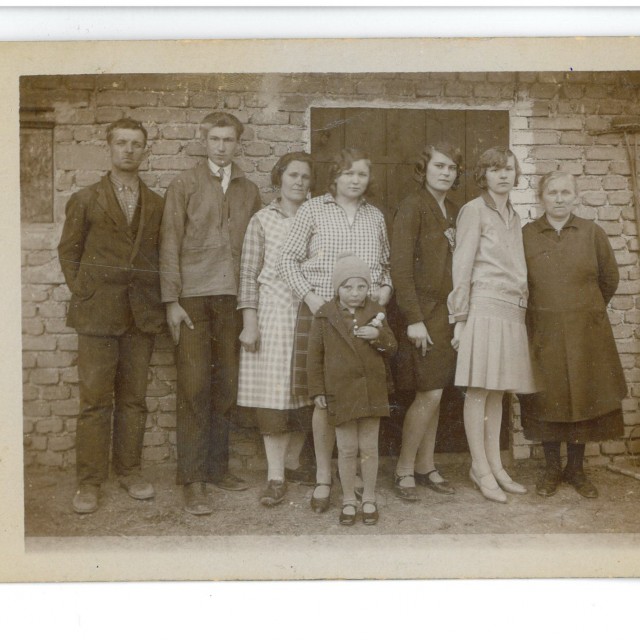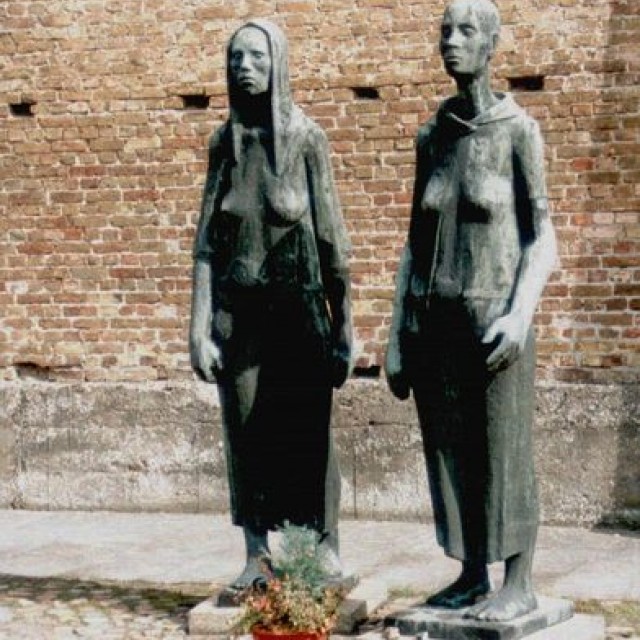From Bed Straight to Concentration Camp
When the women from Lidice were transported to the Ravensbrück concentration camp in June 1942, they had no idea what to expect. They were absolutely not prepared for situations that were common in such places. Milada Cábová recalls: “You cannot imagine how taken aback we were. We did not know where we were being transported to. We went from bed straight to the concentration camp, so to say…” Žofie Červená, a Czech woman who had already been in the camp for longer, took care of them. She explained to them how things in the camp worked, what they had to do and what they had to avoid. Once, two women were chosen for a transport, and because all the chosen women were elderly, it became obvious that it was the death transport. Milada Cábová recalls: “Ms. Červená spoke perfect German and she was fairly famous in the camp. For a while she was the head of the Strafblock, which was the block for women who could not work so hard or who could not keep up with the others. So she was fairly influential, so to say. She would stop by at our block every once in a while, when we still lived in the block 11. She gave us advice what to do and what to avoid. So, Milka Zbrojková and I decided to find her and tell her that our mothers were chosen for the transport and begged her if she could do something about it. And Ms. Červená took both of them off of the transport list and substituted their names with different names. These other two women unfortunately got the worst of it. But my mother and Ms. Zbrojková were saved.” The Czech women in the concentration camp tried to help the women from Lidice to handle the situation, and thanks to that a fairly large number of Lidice women managed to survive the concentration camp.
Hodnocení
Abyste mohli hodnotit musíte se přihlásit!
Trasy
Příběh není součastí žádné trasy.
Komentáře

Milada Cábová
Milada Cábová, by maiden name Říhová, was born in 1924 in Lidice. The Říhas raised two daughters, Milada and her sister Věra, who was ten years older and came from her mother’s previous marriage. The Říha family lived in the house number 89 in Lidice. Milada attended school in Buštěhrad, where she was trained to become a dressmaker. She was not able to finish her studies, however, because in June 1942, she was arrested, together with the other inhabitants of Lidice, and subsequently transported first to the building of the grammar school in Kladno, and from there straight to the forced labor camp in Ravensbrück. There, in the harsh conditions of the camp, Ms. Milada and her mother survived the war. Towards the end of the war, the Nazis attempted to get rid of the majority of the victims of forced labor camps and Ms. Milada was therefore, along with the other women from Lidice, sent on the Schwerin March during the night of April 27/28. However, the procession never made it to Schwerin. The guards were so afraid of the Red Army soldiers and the approaching front that they abandoned the women. The women finally arrived to Crivitz, where they met Czech men who were marching from the Sachsenhausen concentration camp. Both groups settled down in a forest camp and waited for liberation. They were liberated by the Red Army on May 2, 1945. Antonín Zápotocký, who was among the men from Sachsenhausen, began immediate negotiations with the Russians. He arranged the transportation of the Lidice women to Neubrandenburg and from there to Kladno. Only at the Czechoslovak border were the women told by soldiers about the annihilation of Lidice village. Buses took them to Buštěhrad where Ms. Mialda and her mother were picked up by her sister’s husband who took them to his house in Stehelčeves. After two days, Milada´s fiancé František Cába came to visit her. He had waited for Milada the entire three years and had regularly sent her packages to the Ravensbrück camp. All of the Lidice women were given flats from the Kladno municipality. Milada and her mother lived in one of these flats until her fiancé got a flat in Prague. In the meantime, Milada married František in August, 1945. Their son Lubor was born in August, 1946 and four years later, their daughter was born. Milada started to work at Ruzyně Airport in 1961. At first, she was hired as a flight clerk and later she joined the passport/custom department where she was responsible for visas and exit clauses for flight staff. At the same time she also completed her education at an evening school and passed the graduation exams.






